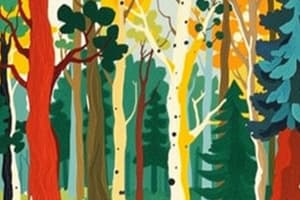Podcast
Questions and Answers
Кой от следните фактори представлява заплаха за дървесните видове?
Кой от следните фактори представлява заплаха за дървесните видове?
- Устойчивото горско стопанство
- Опазването на горите
- Контролираното селско стопанство
- Обезлесяването (correct)
Кое от следните твърдения е вярно за ролята на дърветата в екосистемите?
Кое от следните твърдения е вярно за ролята на дърветата в екосистемите?
- Дърветата допринасят за подобряване на качеството на въздуха (correct)
- Дърветата не абсорбират въглероден диоксид
- Дърветата нямат културна стойност като източници на лекарствени съставки
- Дърветата не играят роля за стабилността на почвата
Кое от следните твърдения е невярно за заплахите за дървесните видове?
Кое от следните твърдения е невярно за заплахите за дървесните видове?
- Инвазивните видове могат да имат разрушителни последици върху горите
- Миннодобивните дейности могат да застрашат дървесните видове
- Болестите не представляват заплаха за дървесните видове (correct)
- Урбанизацията може да бъде заплаха за дървесните видове
Какво е значението на разбирането на различните дървесни видове?
Какво е значението на разбирането на различните дървесни видове?
Кое от следните твърдения е невярно за икономическото значение на дърветата?
Кое от следните твърдения е невярно за икономическото значение на дърветата?
Какво характерно отличие имат иглолистните дървета (coniferous trees) спрямо широколистните (deciduous trees)?
Какво характерно отличие имат иглолистните дървета (coniferous trees) спрямо широколистните (deciduous trees)?
Кое е общо между иглолистните дървета и твърдите (hardwood) дървета?
Кое е общо между иглолистните дървета и твърдите (hardwood) дървета?
Каква е основната разлика между широколистните и иглолистните дървета?
Каква е основната разлика между широколистните и иглолистните дървета?
Кое от следните е общо за твърдите дървета и иглолистните?
Кое от следните е общо за твърдите дървета и иглолистните?
За какво се използва обикновено мекият (softwood) лумбер?
За какво се използва обикновено мекият (softwood) лумбер?
Flashcards are hidden until you start studying
Study Notes
Forest Week Lesson: Tree Species
Forests are diverse ecosystems that house a wide range of organisms, including trees. Understanding tree species is crucial for managing and conserving forests effectively. In this section, we will delve deeper into the different types of trees found in forests.
Coniferous Trees
Coniferous trees, also known as evergreens, are characterized by needle-like leaves that remain green throughout the year. Examples of conifers include pine, spruce, fir, hemlock, and cypress. These trees play a significant role in providing food and shelter for animals, especially in winter months when deciduous trees lose their leaves.
Deciduous Trees
Deciduous trees, unlike conifers, shed their leaves annually, typically during autumn. Some common examples of deciduous trees include oaks, maples, willows, birches, and poplars. These trees contribute to the seasonal variation in color seen in many forests, making them popular for scenic drives and landscape photography.
Hardwood Trees vs Softwood Trees
Hardwood trees produce broad, flat seeds called samaras or achenes. They generally grow slower than softwood trees and require more light for photosynthesis. The lumber derived from hardwood trees is often used for furniture, cabinetry, and flooring because of its durability. On the other hand, softwood trees, such as pines and spruces, produce cones. Softwood lumber is commonly used for construction due to its strength, low cost, and ease of availability.
Economic Importance of Trees
Trees provide numerous economic benefits. They offer timber for building and manufacturing purposes, absorb carbon dioxide through photosynthesis, improve air quality, maintain soil stability, and protect against wind erosion. Additionally, trees have cultural value as sources of medicinal ingredients, food, and raw materials for paper production.
Threats to Tree Species
Some tree species face threats from human activities such as deforestation, urbanization, mining, and pollution. Invasive species and disease outbreaks, like the Emerald Ash Borer, can also have devastating impacts on forest ecosystems. Consequently, it is essential to promote sustainable forestry practices and monitor the health of tree populations to mitigate these threats.
In conclusion, understanding tree species is fundamental to forest conservation and management. By learning about different types of trees and their roles in forests, we can appreciate the complexity and importance of these ecosystems.
Studying That Suits You
Use AI to generate personalized quizzes and flashcards to suit your learning preferences.



